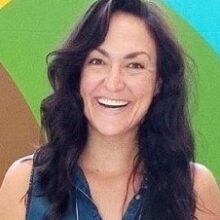When the NIH and FDA canceled their Rare Disease Day celebration in Bethesda on February 28, TMA, in partnership with Nori’s Fight and Myositis International Health and Research Collaborative Alliance (MIHRA), brought the myositis community together virtually to share the latest in myositis research and hear those who live with these diseases tell the stories of their myositis journeys. This is a recap of one of those stories: TMA member Lindsay Guentzel’s keynote address.
For Lindsay Guentzel, it all started with a cactus. Her journey with dermatomyositis and antisynthetase syndrome began with getting cactus spines in her leg while hiking in Arizona. A severe reaction took her to the emergency department where she was diagnosed with cellulitis. She continued to get worse, though, and less than three months later—quick for a rare disease, she acknowledges—she got her diagnosis.
Lindsay shared that in the two years since then, she has had more than 350 medical appointments, spent 24 days in the hospital, had more than 10 emergency department visits, and spent nearly 250 hours in infusion chairs. The job of managing her health means maintaining her often disruptive appointment schedule, managing her medications and their sometimes-grueling side effects, waging insurance battles, and investigating clinical trials. Treatment rooms, she says, have become her office so she can also continue to do the work she loves as a multimedia journalist.
There are questions about each medication she takes with no space to consider them. She’s also had an unexpectedly hard time getting people to believe her. It’s a lot, and it can be exhausting. Even while people show up for her, it still comes down to her.
But she’s still here, she says. And despite everything, she’s happy with her life and grateful for the myositis community. She wants others who live with these challenging diseases to feel their struggles have been seen and understood.
“Every single day I fight,” she says. “To be seen, to be heard, to make sure the people who come after me don’t have to fight this hard. We need funding for research, we need doctors trained to recognize rare diseases, we need health care systems that work for patients not against them, because the simple fact is, rare disease is not rare.”
